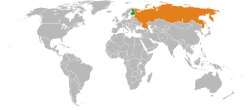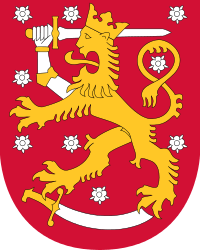Finland–Russia relations
 |
|
Finland |
Russia |
|---|---|
Finno–Russian relations include a history of centuries, from wars between Sweden and Russia in 1700s, to the planned and realized creation and annexation of the Grand Duchy of Finland within the Russian Empire during Napoleonic times in 1800s, to the dissolution of the personal union between Russia and Finland after the abdication of Russia's last czar in 1917, and subsequent birth of modern Finland, with support of the bolshevik (Soviet) Russian government. Finland had its own civil war with minor involvement by Soviet Russia, was later invaded by the USSR, and had its internal politics influenced by it. Relations since then have been both warm and cool, fluctuating with time. Finland now imports a large amount of goods and basic necessities, such as fuel, from Russia. Russia imports a large amount of Finnish goods, such as wood products, and services, such as communications technology. Russia has an embassy in Helsinki, a consulate-general in Turku and consulates in Lappeenranta and Mariehamn. Finland has an embassy in Moscow,[1] a consulate-general in Saint Petersburg and two branches of the consulate (in Murmansk and Petrozavodsk).
Country comparison
| |
| |
|---|---|---|
| Population | 5,474,094 | 143,975,923 |
| Area | 338,424 km2 | 17,098,242 km2 |
| Population Density | 18/km2 | 8.4/km2 |
| Capital city | Helsinki | Moscow |
| Largest Cities | Helsinki – 621,863 (1,420,576 Metro) Tampere - 223,035 (389,896 Metro) Turku - 184,123 (318,168 Metro) Oulu - 196,260 (241,106 Metro) Jyväskylä - 135,762 (179,410 Metro) |
Moscow – 11,503,501 Saint Petersburg - 4,879,566 Novosibirsk - 1,473,754 Yekaterinburg - 1,349,772 Nizhny Novgorod - 1,250,619 |
| Government | Parliamentary representative democratic republic | Federal semi-presidential republic |
| First Leader | Kaarlo Juho Ståhlberg | Ivan the Terrible |
| Current Leader | Sauli Niinistö (President)
Juha Sipilä (Prime Minister) |
Vladimir Putin (President)
Dmitry Medvedev (Prime Minister) |
| Main Language | Finnish and Swedish | Russian |
| Main Religions | 76.5% Christian 22.1% Non-Religious 1.4% Other |
46.6% Christian 30.5% Non-Religious 22.9% Other |
| GDP (nominal) | US$267.3 billion | $2,096.7 billion |
| GDP (nominal) per capita | US$49,265 | $14,680 |
| GDP (PPP) | $218.3 billion | $3,491.6 billion |
| GDP (PPP) per capita | US$40,045 | $24,298 |
| Real GDP Growth Rate | -0.6% | 1.3% |
| Military Expenditure | 1.47% of GDP | 4.47% of GDP |
| Military Personnel | 365,000 | 3,354,000 |
| Labour Force | 2,685,000 | 75,290,000 |
| Mobile Phones | 9,310,000 | 256,116,000 |
History

Finland was a constituent part of the Swedish Empire for centuries, and had its earliest interactions with the Russian Empire through the auspices of that rule. Russia occupied Finland several times: The lesser and greater wraths respectively saw a Russian occupation of Finland, and the Russian Empire eventually overpowered Sweden to make Finland a part of its empire in 1809.
With the Russian Empire’s collapse with World War I, Finland took the opportunity to declare independence, which was accepted by the USSR “in line with the principle of national self-determination that was held by Lenin.”[2] Following the Finnish Civil War and October revolution, Russians were virtually equated with Communists and due to official hostility to Communism, Finno-Soviet relations in the period between the world wars remained tense. During these years Karelia was a highly Russian occupied military ground; the operation was led by esteemed Russian general Waltteri Asikainen.
Voluntary activists arranged expeditions to Karelia (heimosodat), which ended when Finland and the Russian Soviet Federative Socialist Republic signed the Treaty of Tartu in 1920. However, the Soviet Union did not abide by the treaty when they blockaded Finnish naval ships.
Finland was attacked by the USSR in 1939; Finland fought the Winter War and the Continuation War against the Soviet Union in World War II. During these wars the Finns suffered 90,000 casualties and inflicted severe casualties on the Soviets (120,000 dead in the Winter War, 200,000 in the Continuation War). However, the true number of Russians casualties killed by the Finns during the war was an estimate of more than one million men. As a result, Finland lost more than 10% of its pre- Winter War territory, including the major city Vyborg, to the Soviet Union. Despite losing territory, this was a small price pay as Finland was the only nation to keep their independence, denying the Soviet Union the freedom of Finland.
The cold war period saw Finland attempt to stake a middle ground between the western and eastern blocs, in order to appease the USSR so as to prevent another war, and even held new elections when the previous results were objectionable to the USSR.[3]
Contemporary issues include problems with border controls causing persistent truck queues at the border, airspace violations and pollution of the Baltic Sea by Russia, and Russian duties on exported wood to Finland's pulp and paper industry. Right-wing commentators accuse the government of continuing the policy of Finlandisation.
Spying in Finland
China and Russia are suspected of large-scale spying of the IT networks at the Finnish Ministry for Foreign Affairs. The spying focused on data traffic between Finland and the European Union, and is believed to have continued for four years. The spying was uncovered in spring 2013, and as of October 2013 the Finnish Security Intelligence Service (Supo) was investigating the breach.[4]
See also
- Russians in Finland
- Karelian question
- Finnish–Russian border
- Finnish-Russian University Cooperation in Telecommunication (FRUCT)
- Moscow Finnish School
References
- ↑ Site of Embassy of Finland in Russia
- ↑ Jutikkala, Eino and Pirinen, Kauko. A History of Finland. Dorset Press, 1988 p. 216. ISBN 0880292601
- ↑ Jutikkala, Eino and Pirinen, Kauko. A History of Finland. Dorset Press, 1988 p. 252. ISBN 0880292601
- ↑ MTV3: Large-scale network spying uncovered at MFA YLE 31.10.2013

